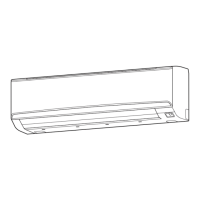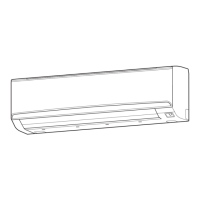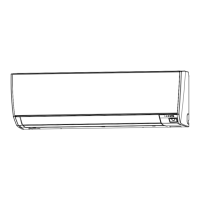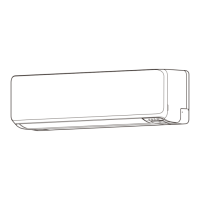En-11
6.2. Custom code setting
• Selecting the custom code prevents the indoor unit mix-up. (figure below)
(Up to 4 codes can be set.)
• Perform the setting for both the indoor unit and the remote controller.
Code change
Indoor unit
Remote
controller
Confusion
A B C D
A B C D
• Custom code setting for indoor unit
Set the DIP switch SET3 SW1, 2, referring
to the figure and table below.
IU AD REF AD RC AD
×10 ×1 ×10 ×1
SET3 SET4
DIP switch “SET3”
SW
1
SW
2
SW
3
SW
4
ON
OFF
DIP switch “SET3”
DIP switch
SET3
Custom code
A (Factory
setting)
BCD
SW1 OFF ON OFF ON
SW2 OFF OFF ON ON
6.3. Function setting
WARNING
Please make this setting after completing all construction works.
• FUNCTION SETTING can be performed with the wired or wireless remote controller.
(The remote controller is optional equipment)
• Refer to the wired or wireless remote controller manual for detailed setting information.
• Refer to “6.1. Setting the address” for indoor unit address and refrigerant circuit address
settings.
• Turn the power of the indoor unit ON before starting the setting.
* Turning on the power to the indoor units initializes EEV, so make sure the piping air tight
test and vacuuming have been conducted before turning on the power.
* Also check again to make sure no wiring mistakes were made before turning on the
power.
Function details
Function
Function
number
Setting number Default Details
Filter
indicator
interval
11
00 Standard
Adjust the filter cleaning interval
notification. If the notification is too
early, change to setting 01. If the
notification is too late, change to
setting 02.
01 Longer
02 Shorter
Filter
indicator
action
13
00 Enable
Enable or disable the filter indica-
tor. Setting 02 is for use with a
central remote controller.
01 Disable
02
Display only
on central
remote con-
troller
(Forbidden) 20 00
(Forbidden) 23 00
Horizontal
swing
airflow
direction
24
00 Standard
Adjust the horizontal swing airflow
direction.
(For horizontal swing equipped
models)
01 Left half
02 Right half
(Forbidden) 26 31
Cool air
tempera-
ture trigger
30
00 Standard
Adjust the cool air trigger tempera-
ture. To lower the trigger tempera-
ture, use setting 01. To raise the
trigger temperature, use setting 02.
01 Adjust (1)
02 Adjust (2)
Heat air
tempera-
ture trigger
31
00 Standard
Adjust the heat air trigger
temperature. To lower the trigger
temperature by 6 degrees C, use
setting 01. To lower the trigger
temperature by 4 degrees C, use
setting 02. To raise the trigger
temperature, use setting 03.
01 Adjust (1)
02 Adjust (2)
03 Adjust (3)
Auto restart
(*1)
40
00 Enable
Enable or disable automatic system
restart after a power outage.
01 Disable
Cool Air
Prevention
43
00 Super low
Restrain the cold airflow with mak-
ing the airflow lower when starting
heating operation. To correspond to
the ventilation, set to 01.
01
Follow the
setting on
the remote
controller
External
control
46
00 Start/Stop
Allow an external controller to start
or stop the system, or to perform
an emergency stop.
If an
emerge
ncy stop is performed
from an external controller, all re-
frigerant systems will be disabled.
If forced stop is set, indoor unit
stops by the input to the external
input terminals, and Start/Stop by a
remote controller is restricted.
01
Emergency
stop
02 Forced Stop
Error report
target
47
00 All
Change the target for reporting er-
rors. Errors can either be reported
in all locations, or only on the
central remote controller.
01
Display only
on central
remote con-
troller
Fan setting
when
cooling
thermostat
OFF
49
00
Follow the
setting on
the remote
controller
When set to 01, the fan stops when
the thermostat is OFF in cooling
operation. Connection of the wired
remote controller (2-wire type)
and switching its thermistor are
necessary.
01 Stop
Switching
functions
for external
inputs and
external
outputs
terminals
(*2)
60
00 Mode 0
• Set this function when connecting
the VRF system to a ventilator,
economizer, humidifier, or other
external device.
• The connection terminal functions
can be changed depending on
the type of external device. For
details of the connection terminal
functions, see the Design &
Technical Manual.
01 Mode 1
02 Mode 2
03 Mode 3
04 Mode 4
05 Mode 5
06 Mode 6
07 Mode 7
08 Mode 8
Control
switching
of external
heaters
61
00
Auxiliary
heater con-
trol 1
Sets the control method for the
external heater being used. For
details of the control method, see
the Design & Technical Manual.
01
Auxiliary
heater con-
trol 2
02
Heat pump
prohibition
control
03
Heater selec-
tion control
using outdoor
temperature 1
04
Heater selec-
tion control
using outdoor
temperature 2
05
Auxiliary
heater control
by outdoor
tempera-
ture 3
06
Auxiliary heat
pump control
07
Auxiliary heat
pump control
by outdoor
tempera-
ture 1
08
Auxiliary heat
pump control
by outdoor
tempera-
ture 2
09
Auxiliary heat
pump control
by outdoor
tempera-
ture 3
Operating
tem-
perature
switching
of external
heaters
62
00 Setting 0
• Sets the temperature conditions
when the external heater is ON.
• For the temperature conditions,
see "Temperature conditions
when the external heater is ON".
For a more detailed explana-
tion, see the Design & Technical
Manual.
01 Setting 1
02 Setting 2
03 Setting 3
04 Setting 4
05 Setting 5
06 Setting 6
07 Setting 7
08 Setting 8
09 Setting 9
10 Setting 10
11 Setting 11
12 Setting 12
13 Setting 13
14 Setting 14
15 Setting 15
16 Setting 16
17 Setting 17
Auto mode
type (*3)
68
00
Single setpoint
auto mode
(traditional)
Switch the setting method of
auto mode to single or dual
(cooling/heating).
For heat pump systems, it is
necessary to set the master indoor
unit (by wired remote controller).
01
Dual setpoint
auto mode
9373370475-01_IM.indb 119373370475-01_IM.indb 11 9/16/2019 2:31:28 PM9/16/2019 2:31:28 PM

